河南开封人,毕业于河南大学。
主要作品
《道边》
《乡村游乐场》
《车上的中原人》
《在那儿》
《落寞的狂欢》
《弥漫》
《冬日午后》
《慢慢地游走》
《标本生活》
《失神记》
《桃花源记》
《新桃花源记》
《葬花记》
《非是》
《静穆四合》
《很像生活的生活》
《铁灰色的风景》
展览
2014年3月 《静穆四合》田野摄影展 全摄影画廊 上海
2013年 《暗涌》田野新影像展 影响艺术空间 开封
2012年 《静穆四合》 连州国际摄影节 连州
2012年 《非是》 度空间馆 开封
2011年 《谁的风景》 大理国际影会 大理
2010年 《桃花源记》(续) 左岸7号艺术空间 洛阳
2010年 《桃花源记》, 全摄影画廊 上海
2007年 《慢慢地游走》 全摄影画廊 上海
2003年 《心境》 洛阳
2002年 《城市边缘的风景》 郑州联展
2015年 《映》 《鱼》 首届长江国际影像双年展 重庆
2015年 《映》,《鸟》 “无界”艺术展 洛阳
2014年 《静穆四合》 中国当代影像10年 连州
2014年 《静穆四合》 上海艺术影像展 上海
2014年 《新桃花源》 犁面沟艺术部落 登封
2014年 《慢慢游走》 《静穆四合》 台北国际当代艺术博览会 台北
2013年 《慢慢游走》 “濡湿”摄影群展 上海
2012年 《非是》 德国 汉堡
2012年 《慢慢地游走》 上海城市艺术博览会 上海
2012年 《慢慢地游走》 德国 汉诺威
2011年 《慢慢地游走》 意大利亚力山德里亚双年展
2010年 《非是》 中国当代艺术展 谷仓艺术中心 兰州
2009年 《慢慢地游走》, 艺术北京 北京
2009年 《新桃花源记》 河南石佛当代艺术大展 郑州
2008年 《幸福生活》 改革开放三十年河南当代艺术展 郑州
2008年 《慢慢地游走》 全摄影画廊, 北京
2007年 《慢慢地游走》 平遥国际摄影大展 平遥
2006年 《边缘的风景》 河南摄影五十年大展 河南博物院
2006年 《弥漫》 河南摄影五十年大展 河南博物院
2005年 《慢慢地游走》 “丰”中国当代影像艺术展 上海艺术景艺
术中心
2004年 《城市边缘的风景》 平遥国际摄影大展 平遥
2003年 《车上的中原人》 中国人本摄影大展 广州美术馆
2003年 《乡村游乐场》 中国人本摄影大展 广州美术馆
2003年 《车上的中原人》 平遥国际摄影大展 平遥
2002年 《冬日午后》 平遥国际摄影大展 平遥
2000年 《在那儿》 河南星期八艺术展 河南轻工学院展览馆
1998年 《道边》 河南九八提名展, 河南升达艺术馆
收藏
2006 《边缘的风景》系列,河南博物院
2006 《弥漫》系列,河南博物院
2003 《乡村游乐场》,广州美术馆
2003 《车上的中原人》,广州美术馆
发表
《游走》 《弥漫》《静穆四合》《馄饨》《非是》等系列作品200多幅发表在法国《摄影》《中国摄影》《人民摄影》《艺术世界》《当代美术》《ART概艺术指南》,《边缘艺术》《十方艺术》《精英》等重要的专业杂志和报刊上。
Tian Ye
Born in Kaifeng, Henan.
Graduated from Henan University.
Solo Exhibitions
2014 All Things are in Silent, OFOTO Gallery, Shanghai
2010 Memory of a Peach Bower, OFOTO Gallery, Shanghai
2007 Wandering Slowly, OFOTO Gallery, Shanghai
2003 Feelings, Luoyang
2002 The Scenery in the Suburbs, Zhengzhou
Group Exhibitions
2014 Photo Shanghai, Shanghai Exhibition Center, Shanghai
2013 Wetting, OFOTO Gallery, Shanghai
2011 Biennale of Alessandria 2011, Alessandria, Italy
2009 Wandering Slowly, Art Beijing, Beijing New Memory of A Peach Bower, Contemporary Art Exhibition in Shifo, Henan
2008 FOTO · OFOTO, OFOTO Gallery, Beijing
Happy Life, Memorial Contemporary Art Exhibition of the 30th
Anniversary of China’s Reform and Opening in Henan, Zhengzhou
Wandering Slowly, OFOTO Gallery, Beijing
2007 Wandering Slowly, Pingyao International Photography Festival, Shanxi
2006 Exhibition Celebrating Fifty Years of Henan Photography, Henan Museum, Henan
2005 The Modern Chinese Image Art Show, Shanghai Image Art Gallery, Shanghai
2004 The Scenery in the Suburbs, Pingyao International Photography Festival, Shanxi
2003 The Chinese Humanism Photography Exhibition of Guangdong, Guangzhou Art Museum, Guangzhou
The Peasants in the Wagon, Pingyao International Photography Festival, Shanxi
2002 Afternoon in Winter, Pingyao International Photography Festival, Shanxi
2000 By There, The Henan Art Exhibition, Exhibition Centre of the Light Industrial College, Henan
1998 The Henan Nomination Exhibition in 1998, Shengda Museum, Zhengzhou
Collections
2006 The Scenery on the Rim & Loneliness, Henan Museum, Henan Guangzhou Art Museum, Guangzhou
“Diffuse” series, henan museum
The village amusement park, guangzhou art museum
2003 The Playground in the Country & The Peasants in the Wagon
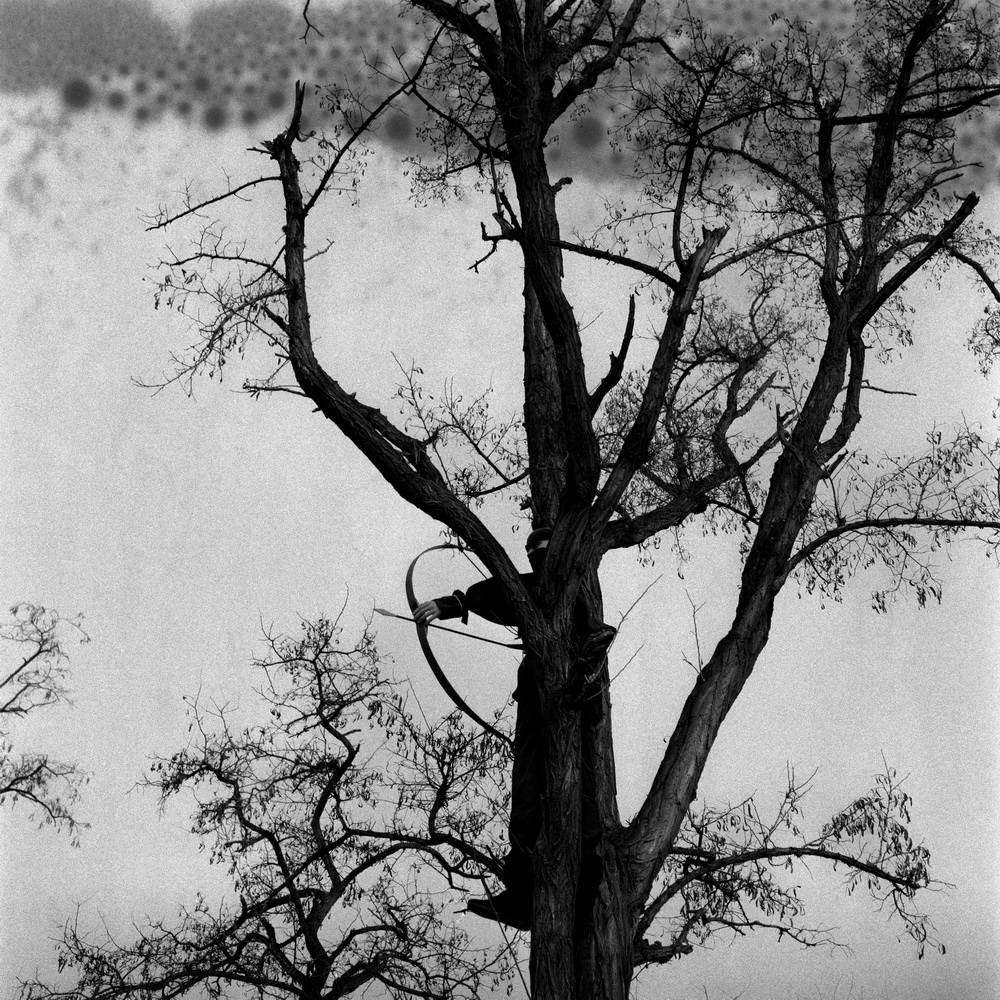
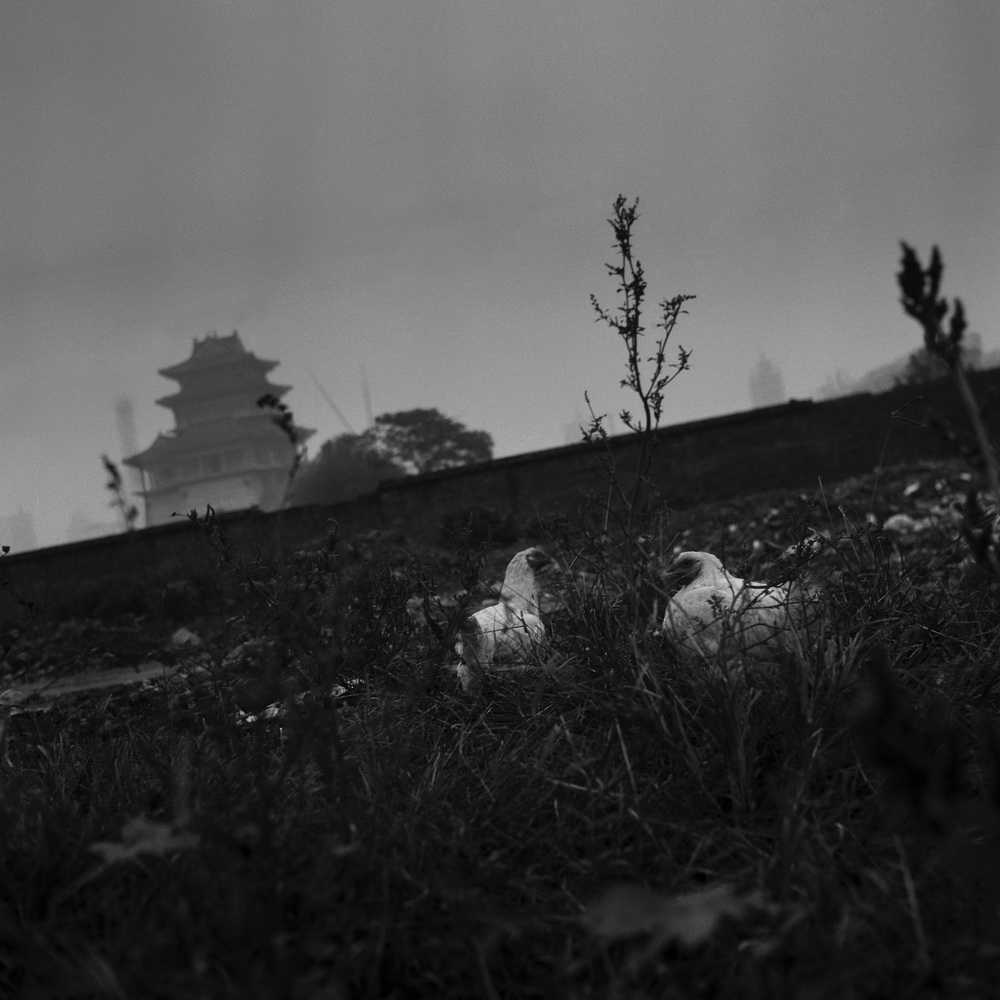
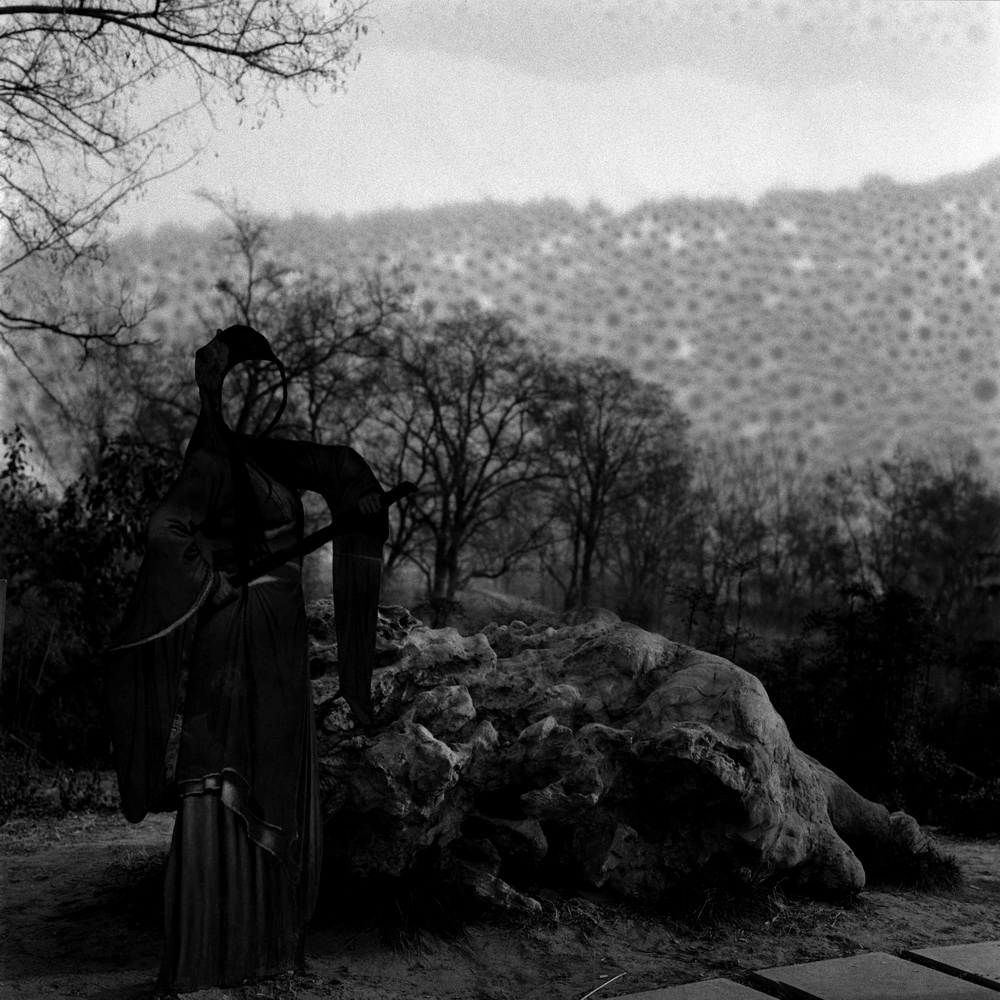
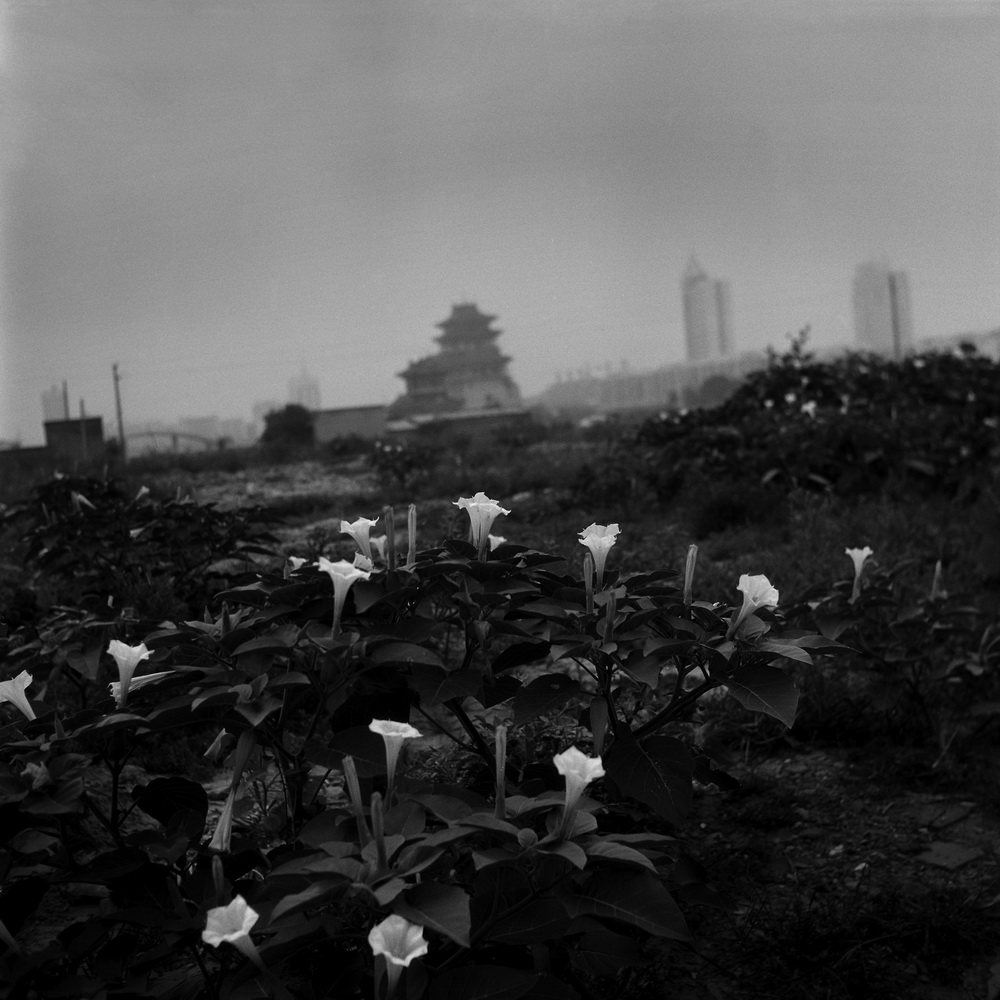
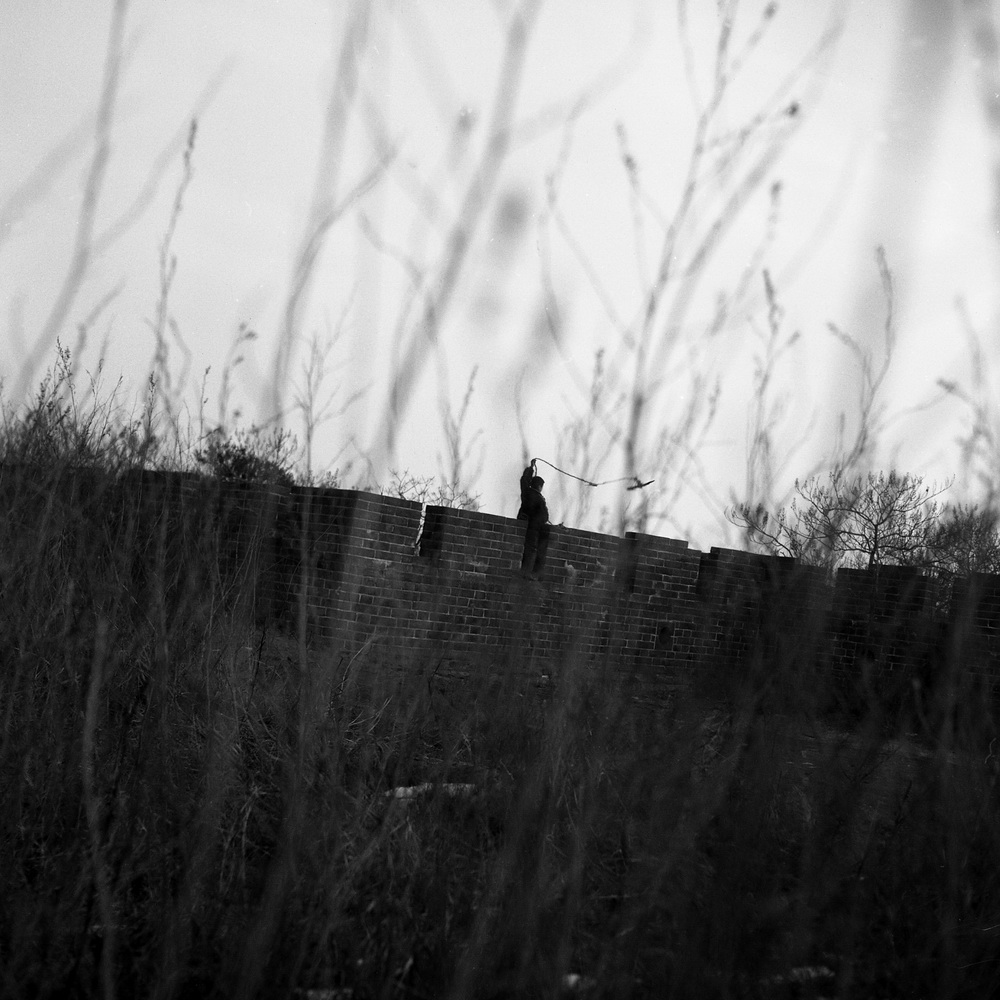
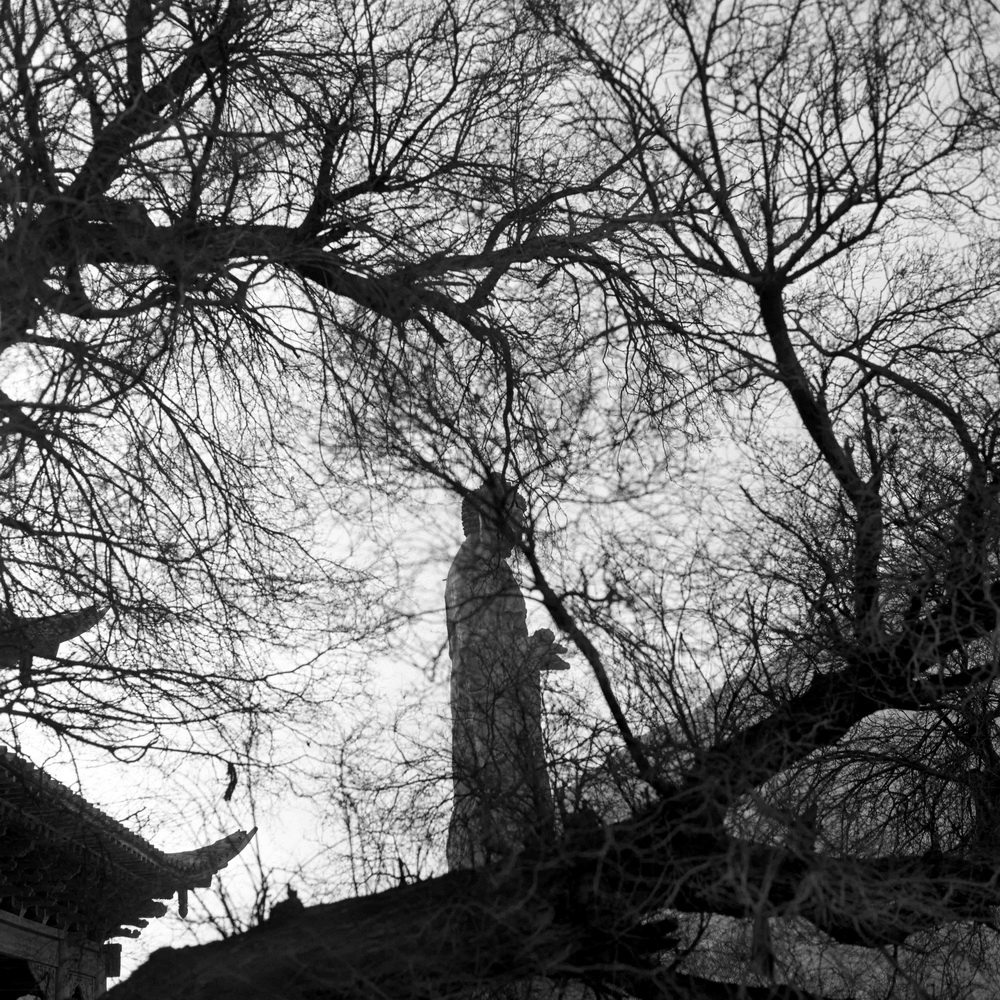
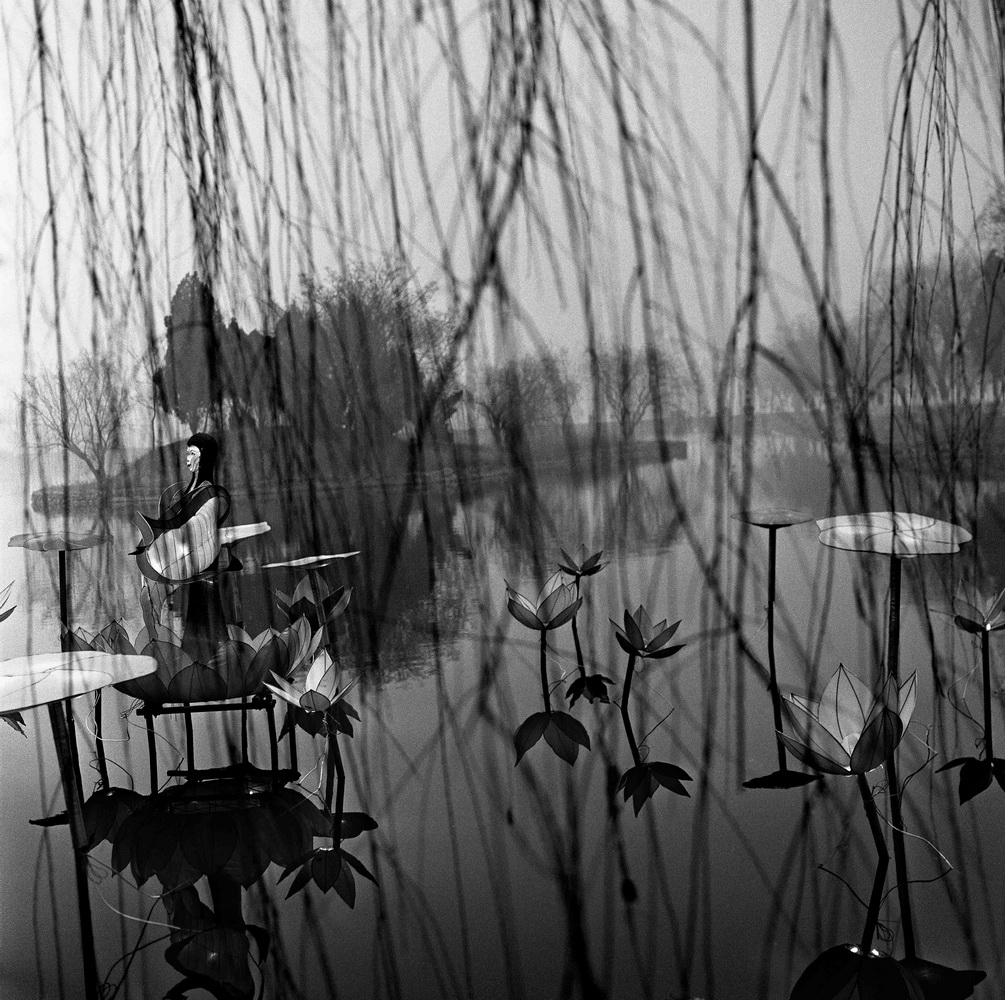
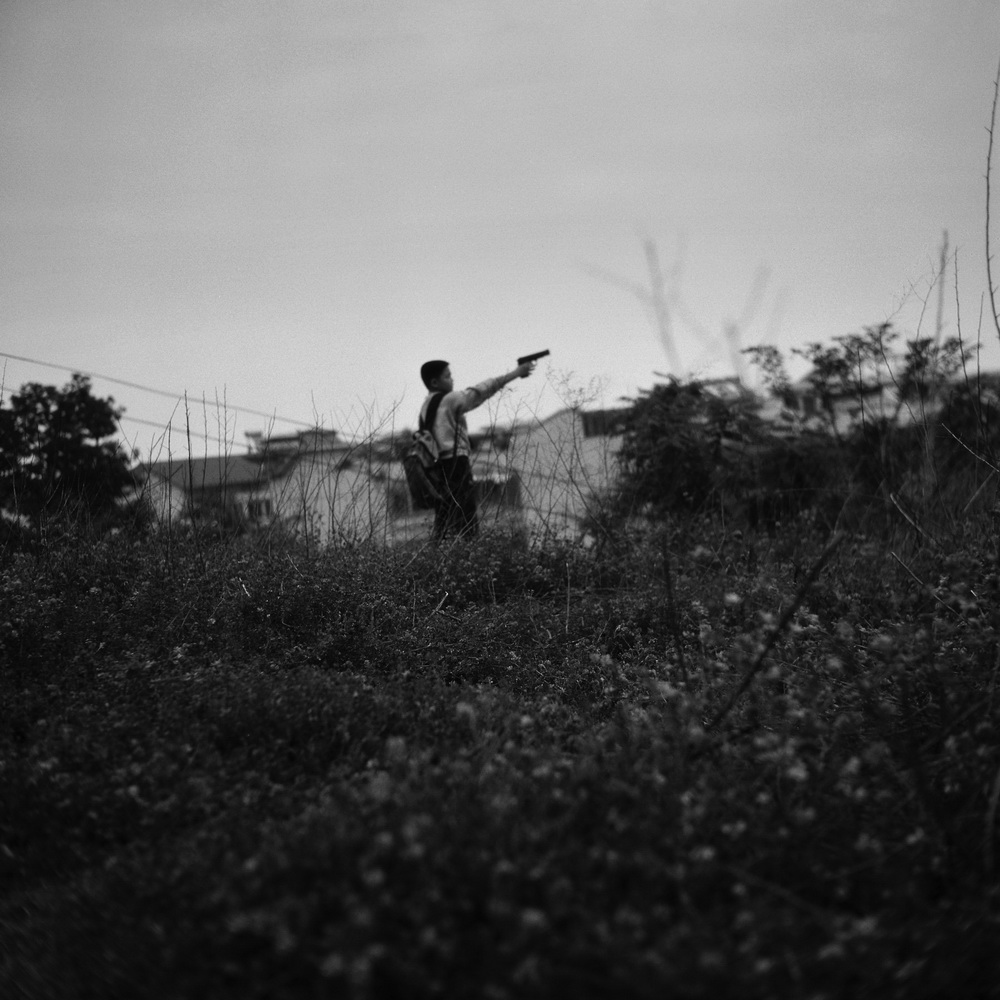
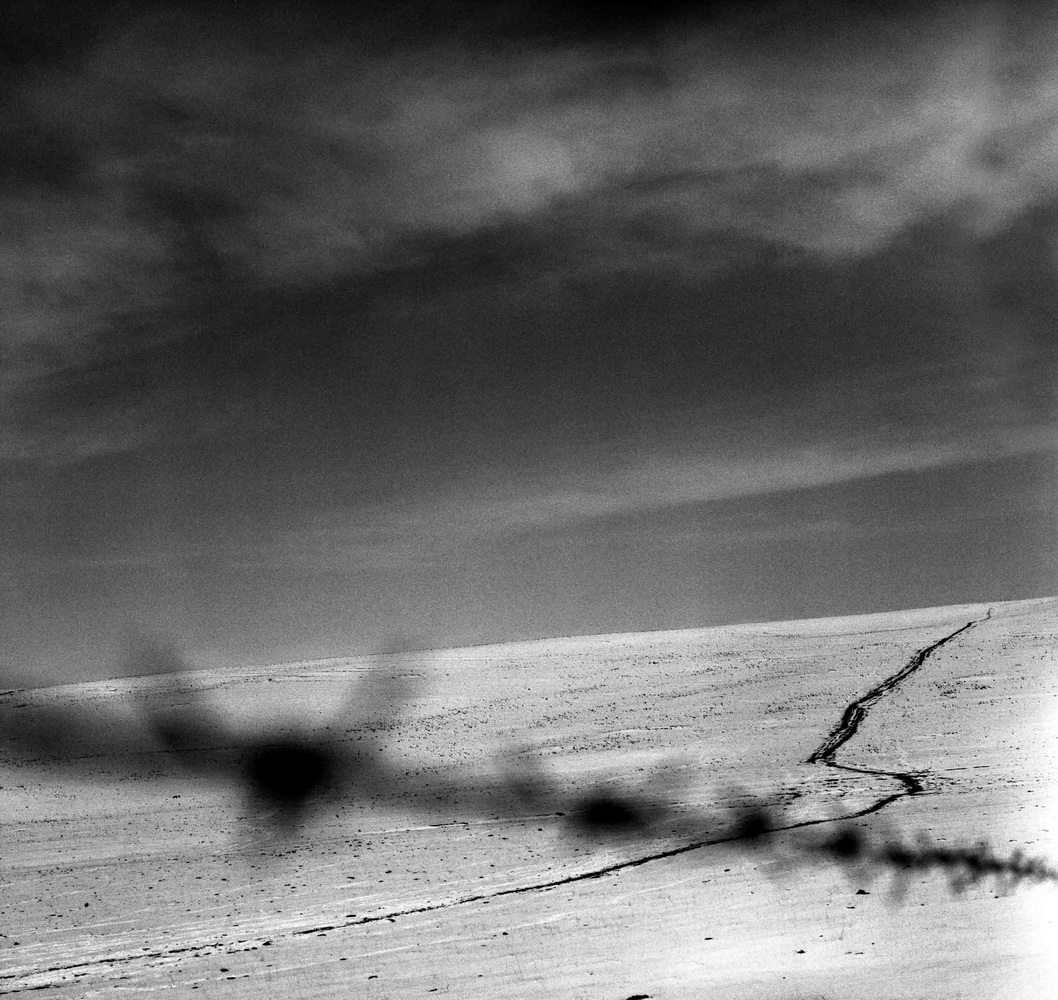
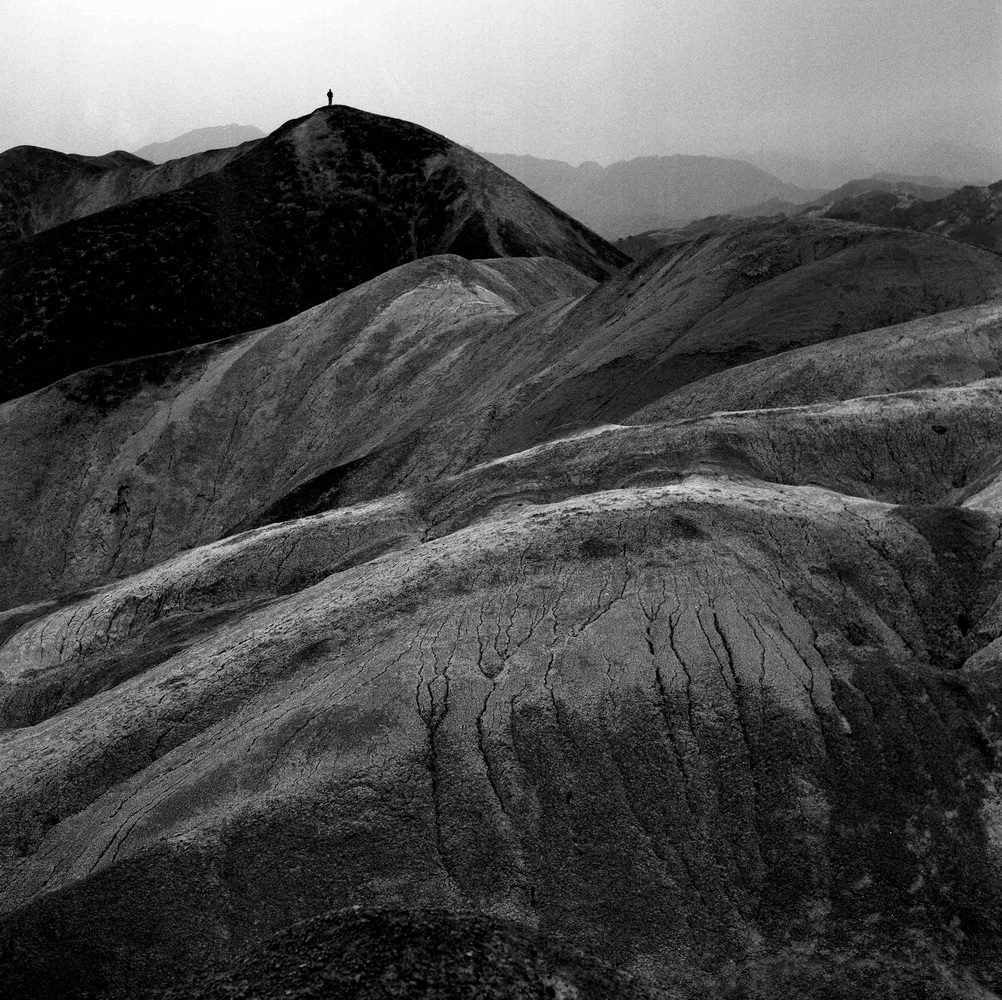
田野的影像
李书玉
田野的影像是晦暗的或者说暧昧的,但却是很有魅力的,并且是一种具有思想深度的感性魅力,田野的影像在提醒我们,当给出事关未来的看法时不要过于凭借自己的知识,即田野的影像叙述了一种思想抉择的困境:我们总要选择未来,但我们不知道哪种未来是更好的。
田野一直是一个想表达严肃思想的摄影家。表达思想就要受事实限制,因为思想是在事实的限制下思想(思想还能制造什么样的事实),从而影像表达思想就受制于摄影文化自身。摄影文化自身是指我们从影像中看着真实的对象这种事,即“看...”是我们的事,我们所做出来的事情就是事实,因而从影像中看到了真实的对象这是一个事实(其实只需最诚实的直观就可以发现这一点),摄影文化自身是一种事实,而不是对某种事实的反映,通常就被叫做“摄影的真实”,摄影文化自身或摄影的本体也就是摄影的真实。观念摄影似乎也表达思想或者说表达具有学术意义的观念,但其“观念”往往只是一些也许打破日常规则的肆无忌惮的想法,并没有学术意义,因为,观念摄影突破了摄影的真实,采用表演、道具并进行拍摄,使人们感受不到摄影文化本身,也就是说,思想或观念的表达并不是我们先有了它然后用某种方式去把它表达出来,而是指,思想在某种表达方式中被构造出来(思想的表达方式同时也是思想的存在形式),因而表达是要在一种事实的限制之下去进行有意义的创造——所以人们总觉得观念摄影不像是摄影,而只是一种观念艺术而已。我们是什么样的取决于我们的创造,比如创造了文学作品就是文学家等等,否则我们什么也不是,人的存在是创造性的。田野敏感到了摄影的真实所蕴含的表达力,他力图在摄影本身中制造出新的事实,用他自己话说是“在真实中进行创造”。
田野和其他摄影艺术家一样,努力用影像所能表明的日常世界真实来创造出超越了日常真实的存在——艺术品是试图展示一个另外的可能世界。其策略就是,谋求一种真正的但又是不太清楚的影像,使得人们能够在肯定影像内容是日常真实对象的同时又看不清影像中的景物细节或场面情节,而同时又不得不尊重这种影像不清楚的状况,即不去试图在知识中把它们恢复成清楚的,因为这里形成了一种具有“非如此不可”的排他性魅力,使人们为事物“如此这般”的状态所诱惑而无话可说。
真正的影像呈现真实对象(展示表演性东西的影像不是真正意义上的影像,正如故事片电影不被归属为摄影),但是,并不是说,真正意义上的影像真的呈现真实对象(比如照片中的苹果不能吃),而是指,影像的内容能够在语言中去被理解、表述、分析和推论,即能够在视觉关系的范围内承受得住逻辑的传递性,比如,我们可以询问“在那幢房子后面被它完全挡住的东西是什么”,而如果我们面对的是一幅绘画就不能这么问——这里经历了逻辑的真值传递:“既然那是一幢房子,就有它后面的空间,那后面的空间里就可能有被它完全挡住的东西”,而在非摄影的图像中无法承受。逻辑的传递性表明,影像显示的是真实对象,影像中的真实对象相当于被摄对象。
但是影像中的真实对象并不等于被摄对象——这个区别很重要:在存在论的意义上,任何被思考的事物都是一个具有主动回应能力的“对手”而不是被观察、被规定的“对象”,所谓“影像中的真实对象”就是指这样的对手,它是处在与我们的互动关系中,“在局中”与我们互动,比如,我们意识到,当我们走近它它就会变大、变清晰等等,如果它受到我们的拍摄行为的干扰就会有相应的反应,诸如此类。很显然,这里显示的是我们的实践性的智慧,而不是显示了被摄对象本身(所以尽管某些照片能够使我们获得关于真实对象的视觉经验,却又总有可能发现它们是假的)。需要补充一点的是:实践性的智慧虽然未必表达了被摄对象本身,但是却能够对付得了被摄对象,所以我们就能够思考一些针对着影像中真实对象的事情,并且这种思考具有实际意义。在知识论的意义上,事物才是“对象”,即,在知识性的眼光中事物被设定为封闭性的个体,具有既定的本质,从而思想已终结于其封闭性(思想的封闭性有助于我们获得关于某物的确定知识,但是其中未见关于物的思想),被摄对象就正是如此。被摄对象是被设定为外在于影像而领先存在的个体,我们对被摄对象只能知之而不能思之。
利用逻辑的传递性思考影像中的真实对象,思考(比如说)走近它、到它旁边去看以及甚至看到它的内部和背后的情况等,这些就是在想象能够使得该对象更清晰、更完备的我们的行动及其结果,因而是想象未来——我们的每个行动都是在选择未来。
但是在田野的作品中,作品自身的思路使得我们很难进行那种合乎逻辑的想象,因为,不清楚的影像的状况使我们获得了一种完整的“当前状态”感觉,即影像形式让事物进入了一个纯粹的美学情景,对于这个美学情景我们没有任何语言能够分析,我们无话可说,而这一无话状态“封住了”那个本来可以凭借语言/逻辑的能力去进入的空间——我们不能去对影像的内容进行进一步的追问和思考。于是,这里实际上成了一个关于一种思想困境的叙事:
美学情景使事物得以保存其无可争议的纯粹感性而不被语言所解构,但是影像之作为影像就在于它能够展示真实对象,因而使得,这种不清楚但又有魅力的影像形式实际是在诱使我们去了解或想象那清晰的情况——欣赏田野的作品时人们都能体会到这一点,而同时又不得不注意,如果凭借语言/知识的能力去对影像的内容进行追溯的话我们就脱离了那个作为美学情景的“当前状态”整体,失去了进行想象活动的价值依据(即不明白我们的想象活动究竟为了什么),于是,这里实际上的情况是,我们不知道我们究竟有没有这样的需要——有些类似于对待魔术表演的心理:人们很想知道魔术的底细但是又怕知道,因为知道了就不好玩了。
画面中那些将要被追溯的影像的内容不能是平淡的日常景象,因为其形式给人以神秘、诡异的感觉,从而所实施的追溯活动要符合那感觉也就是去想象神秘诡异的东西,神秘诡异的东西不属于日常世界,而是另外的可能世界。但是不属于真实世界里的东西却可能支配或影响我们的行动,即假的东西却可能是一种真实的力量——比如想象中的上帝是不真实的,但是上帝却能够决定信徒们的行为选择。我们仍然可以合理地想象。
按照神秘诡异的要求去想象真实的行动,这是使得我们可以更充分地体会到作品所制造出来的“跨可能世界”感觉,即那种使得日常生活世界中的某种东西既有着日常世界的身份又同时有着另一个世界的身份的感觉——而这正是艺术感觉。与宗教不同,宗教虽然也想象另外世界,但是宗教所想象的世界是在彼处,是超越了生活的,而艺术的跨可能世界感觉却仅仅在生活中,在日常事物和关系里。在摄影来说这就是要求我们去想象在真实世界里与对手的互动。
比如,在这里,我们会去想:“在那堵墙的后面会是什么样的情形?”(《非是·殿》)、“如果到了那两个小小的背对着镜头而面向淼淼水域的人物背影的旁边,那俩人物会对我们说些什么?”(《非是·水边》)等等……。显然,这时我们就会立刻遭遇一个问题,即,觉察到:我们需要能够感觉到一个由“各种事情”所组成的整体,因为否则我们就无法为我们所想的这件事进行价值定位,也就是说,我们实际上已经理解到了“任何事情都牵连着各种事情,每个事情都在所有事情之中——从而我们所做的某一件事情才会是有价值的”,然而我们所需要感觉到的那个各种事情整体并非“当前状态”,而我们不可能感觉到一个并非当前状态的整体。于是,不得不发现:我们不知道什么样的行动选择是好的,即不知道什么样的行动选择能够使得我们继续保持那跨可能世界的暧昧感觉。我们可以想象未来,但是我们不可能知道未来。
生活是以整体的方式存在的,而人的每一个行动又都是在不断地加入到生活的整体中去的,于是,生活世界的未来必定是测不准的。正如赵汀阳先生所指出:观念的抉择有两个根本困难:(1)指导我们行动的观念都是在选择某种未来,可是无论多少知识积累都不可能形成关于世界的全部知识,也就不可能构成关于未来的必然推论,因此,知识永远不能证明某个观念在未来实践中的正确性;(2)任何人都几乎不可能有一个关于最好、好、不太好...的严格的偏好排序,即使在某个特殊时刻是可能的,也是不稳定的,因为人类价值体系中并不存在一种绝对的最高价值,而是多种价值并列为最重要价值,高下难分,从而总会遇到许多无法两全的两难选择,或者难以比较的选择。“既然人在知识和价值上都无法绝对证明哪个观念更为可取,人不可能知道什么是确实正确的和真正想要的,我们就陷入了思想抉择的困境。……未来之事是人类思想极限,无人能够知道未来。事实上,人类所有的科学发展、经济发展以及政治制度都是对未来的冒险选择。”
田野的影像把影像的呈现作用从我们的感觉习惯中“拉”了出来。按照我们的感觉习惯,我们就总能够把影像还原为我们所熟知的景象,还原为“只不过如此”的日常的平淡景象,但是田野作品中的那些不清楚的影像的展示具有了相互作证的能力,即它们在循环互证中共同具有了存在的理由,因而“不清楚”就恰好成了它们共同的存在方式——这通常就叫做“构图”。不难理解,只有通过共同存在而形成了一个完整的可能世界,任何一个存在才真的存在,才有地方可以存在,于是,“只有选择了某种共在方式,存在才具有在世的意义”(赵汀阳)。构图是使得画面中各种成分具有着在另一个可能世界里存在的意义,即构图是关于某一个可能世界的构成性(比如当说到某一个画面的“构图不行”就是指它关于一个艺术的可能世界的构成性不足),因此一幅照片如果是有构图的,那就是它不再屈服于我们的感觉习惯,不再只是单纯的照片。艺术作品是一个世界,是一个非常有限的世界,但是,正是这个非常有限的世界才恰恰表现出世界所可能有的那种完整性——真实世界太大太复杂了,我们看不到它的完整性。而这是非常有魅力的感觉。
有魅力是属于我们可以经验到的那个作为美学情景的“当前状态”整体(意境),而不是属于影像内容的逻辑可能性,但是正因为这一点,作品才是在表明世界,也即,在这里逻辑可能性帮助我们获得了一种“对于未来无知”的艺术体验,而我们的不可能知道未来这恰恰就是世界的魅力!——想想看,假如一切都了如指掌,一切都有了定数,那生活还有什么意义?世界还有什么魅力?那样的话,人岂不就退化成了动物?生活岂不就成了固定的程序?所以,赵汀阳先生说:“艺术只不过是引导人去理解世界的一种手段,而决非美学活动的目的,因为人的感性生活最终要落实为‘乐山乐水’诸如此类的天人关系中。”不难看出,我们在艺术的可能世界中的事情和在真实世界中的事情是具有相通性的,而相通性则表明了作为万事之通理的“道”。摄影艺术创作显然应该能够摸得着道。
评论节选
我们从田野的这些看似亦古亦今亦今亦古的这些日常生活中的风花雪月与唱酬应和的画面,发现因为某种巧妙的有意为之的遮蔽和渲染而使得情景显得神秘莫测,而因此会产生的提问则可能是,在这些看似平静、从容、悠游自在的花前月下的画面里,掩映期间的还有什么?经过岁月的迷雾的过滤,今天来到我们眼底的过去,今天我们所面对的历史,今天我们面对的现实当下是不是就是像田野的画面所呈现的那样,看似浪漫而又充满晦涩,看似散漫而又封闭?看似风平浪静而又暗流涌动?而对于他的这个系列本身,我们又想问的是,这种亦影亦画的图像,是不是扩充了我们对于过去的认知对当下的判断,丰富了我们对于影像的固有的表现力?或者说,这是对于已经越来越显得无从把握的现实(包括过去)的一种巧妙的质问和提示?
顾 铮
田野的作品一向就有一种表面内敛的品格。
。。。。。。他的镜头游走在城市——同时也是乡村的边缘,他像一个勤力敏感的拾荒者,看似漫不经心实则小心翼翼地捡拾起被人遗忘的一个个记忆的碎片,这些碎片或是关于童年懵懂的游戏,或是关于青春莫名的感伤,或是关于疲惫的都市人对淳朴乡村的怀念。。。。。。每一个碎片都让人惊异,他隐遁在影像背后自己先战战兢兢地不让进入影像中的人或动物受到惊扰,但是他最后还是笃定地不露声色地成为了“他自己的”影像的主宰。疏离和寂寥的情绪贯穿在他的画面中,隐隐地刺痛观看者,同时也把观看者牵引向正在被淡忘的记忆深处。
张 黎
田野的作品始终充溢着一种古典的美,这些作品与田野的心理密码形影不离,他们穿越表现与被表现的壁垒,一方面呈现出作品气质与当下流行趣味的不同,另一方面也因“了无意义”的悖离而产生了与这个时代毫不相干而又有所干预的关联。作品一以贯之的细腻、敏感、伤怀、无奈、阴霾、沉闷、张力、孤独感、末世感,在那些平静地画面里彰显了沉稳的爆发力。视觉惊艳处往往令人酸楚难挨,手足无措,那诗意并且哀伤的基调,那精妙并且粗犷的构成,那柔靡并且放浪的语言,无不为田野的影像增添了鲜有的美学意味。
慕容拖鞋
Photo Images of Tian Ye
By Li Yushu
Tian Ye's images are gloomy and ambiguous, but charming, in a profound way. Tina's photographic work seems to remind us: when talking about the future, never ever rely on your own knowledge. His images narrate a difficult situation: we need to choose a future, but we don't know which one would lead to a better result.
Tian Ye is a photographer who always wants to express deep thoughts in his work. The expression is enslaved to fact; similarly, photographic expression is enslaved to the nature of photography. Photographic culture itself means we look at the real object from an image, namely "look..." Is our things, our things are made of the fact, so seeing the real object from the image that is a fact, (just the most honest intuition can discover this), photographic culture itself is a kind of facts, rather than to reflect some facts, is often called "real photography.”
Conceptual photography has its own academic theory and meaning, but 'concept' itself does not. Conceptual photographs breaks the reality of photography, it adopts the idea of performance, and uses props to prepare certain situation, helps people feel the concept behind the images which is constructed by the artist. Thus, people normally think that conceptual photography is not photography, it is in the conceptual art category. Tian Ye sensitively feels the expression power of reality, and makes his effort on creating new truths in photography itself, which as he said, "to create in real."
Same with other photographers, Tian Ye utilizes the nature of photography of real to create another possible real world in his pictures. His strategy is to seek a real image, but it is not too clear, enables the people that the image content is certainly everyday of the real object; at the same time, one can't see the scene details or scene in the image, and have to respect this image is not clear, is not to try to put them back to clear in the knowledge, because it forms a kind of exclusive charm, make people think that things with "so that" state is tempting.
Real image rendering real object (show performing what images is not in the true sense, as the feature film was not reclassified as photography), however, is not to say that, in the true sense image really presented real object (for example, you can't eat an apple in a picture), but it means that the content of the image can be in the language and be understood, expressed, analyzed and inferred, and is able to withstand the logical relationship between visual range of transitivity. For example, we can ask "what is the thing blocked by the house”, but if we face a painting, we cannot ask - here is a logical value transfer: "since it is a house, you have it at the back of the space, the space may have been completely blocked", and it cannot exist in non-photographic images. Logic transitivity shows, what the image display is real objects, images of the real object is equal to the subject.
However, real objects in the image is not the same as photographed subjects, this is an important difference: in an ontological sense, any things here are a "rival" with active response ability rather than being observed, the "object", the so-called "image of the real object" refers to such rivals, it is in the interaction with us in the “bureau"; for example, we realize that when we come to it, it will become large, clear, and so on, if it is because of our filming behavior of interference then it will have corresponding reaction. Obviously, shown here is our practical wisdom, instead of showing the subject itself (although from some photos we can get the visual experience of the real object, but there is always a chance to find that they are fake). In addition: although practical wisdom not necessarily expresses the subject itself, but is able to deal with the subject, so we can think about something in the real object in the image, and this kind of thinking has a practical significance. Based on the theory of knowledge, what is the "object", namely, in the eyes of the knowledge of things is set as the sealing ability of an individual, has established the essence of which thought has ended in sealing ability (the ability will help us get certain knowledge about something, but did not include ideas about the object), the subject is just like that. The subject is in the existence of individual images, we understand it, but cannot think about it.
Real objects in the image using the transitivity of logic thinking, thinking comes to see the internal situation behind the images, which means that imagination can make the object clearer and more complete. Our actions and their results is to imagine the future-- our every action is to choose our future.
But in Tian Ye’s photographic work, the work of their own ideas for makes it difficult to imagine those kind of logical, because, unclear status of images give us a complete "current status" feeling, which make us enter into a pure aesthetics scenario that we don't know any language to analysis; then we have nothing to say, and the state of empty words "blocked" what could have gone with language/logic— we can't go into the content of the image for further inquiry. Therefore, here is actually a narrative about a dilemma of mind:
The aesthetic scenario enable things the ability to save its pure perceptual and can not be deconstructed by language; but an image can show real subjects, and thereby, this not clear but attractive image form is actually entice us to understand or imagine a clear situation – when looking at Tian’s work, you can understand the point but have to pay attention, if one uses language/knowledge ability to trace the content of the image then we went out of the "current state" of aesthetic scenario as a whole, and lost the value basis of imaginational activities(that is, fail to understand what we the imaginational activities are supposed to do), so here in fact, we don't know if we have such a need – kind of similar to magic show psychology: people would like to know all the ins and outs of magic but again afraid to know, because you know it wouldn’t be funny is you know it’s fake.
The content of the image which will be traced later is not simply a copy of the insipid everyday scene, because its form gives people a mysterious sense, thus the implementation of activity is to conform the feeling, that is, to imagine the mysterious strange. The mystery does not belong to the everyday world, but could be a world with infinite possibilities. However, these unreal dominates or influences our behaviors, that is to say the fakes may create a power of real—for example, the imagination of God is not true, but God can somehow affect our behaviors. We can continue the imagination reasonably.
In accordance with the requirements of those mysterious stranger to imagine the real action, it is how we can better understand the “possible world" that artist produced in the work. It is something that makes us feel familiar and unfamiliar at the same time- and this is a goal that the photographer intended to achieve. Unlike religion, it is in the everyday things and relationships. Religion creates a different world that is beyond life, and we cannot reach at the moment in our life. Thus, photography requires us to imagine how to interact with rivals in the real world.
Here, for example, we’ll think: "What is behind that wall?" Clearly, we will immediately encounter a problem, that is, to detect: we need to be able to feel a whole thing that composed of many small things, otherwise we can't value the whole, that is to say, "everything is related to a lot of things, one can affect one another- every single thing we’ve done is valuable in the future as a whole", but we can't feel the state of the whole. So, we don't know how making a choice, what is a good or what is bad. When holding an ambiguous feeling towards the world, we can imagine the future, but we never know the future.
Life is in the form of whole existence, and man adds every of his/her action to the whole existence, as a result, the future of a man’s life has been always an uncertainty. As Mr. Zhao Tingyang points out: the concept of choice has two fundamental difficulties: (1) the concept of our actions is in choosing a future, no matter how much accumulation one can never form the knowledge of everything; (2) there is never an absolute standard of best, well, not so good, etc. In the human value system, an absolute highest value never exists, instead, a variety of values is listed at the time, so we always have to choose, to make a decision. The real world is too big to see its entire face. But this is why life is so attractive.
Attractive belongs to "current state" as an aesthetic scenario (artistic conception) that we experience, rather than logical possibility within the image content; because of this, work is showing the world, namely, logical possibility here helps us get a kind of "ignorance" for the future through art experience, and the future or the unknown is exactly the charm of the world! - Think about it, suppose everything is well under control, everything has a limit, and then what is the point of life? The world what charm? In that case, people would be degenerated into animals? Life is not a fixed program? Zhao Ting, therefore, Mr. Yang said: "art is merely a means to guide people to understand the world, and is not the purpose of the aesthetic activities, for man's perceptual life eventually will be implemented to its harmonious relationship to the world.”
It is not hard to see, there is a similarity between things in the art world and things in the real world, while the similarity indicates the principle of Chinese "Tao". Photography clearly should be able to find its own “Tao.”
The idyllic sceneries in Tian Ye’s photographs represent the outskirts landscape in China, where rustic places and urban areas interweave. Although the images convey tranquility, they contain a sense of crisis; the images themselves often disturbed by inharmonic anthropic factors. In threatening that those sceneries might disappear someday, he photographs as a means to solidify this nostalgia and fragments of memories. The straight photography theory, he adopted indicates his personal interpretation of a modern man facing contemporary landscapes. He frankly utilizes the “non-modern” photographic method to against the superficial approach to contemporary art.
From Tianye’s timeless scenarios about daily life, one might find the mystery being enhanced by subtly arranged opaque and shading. A followed question could be, aside from the peace, calm and leisure, what others are hidden from this delicate mystery? Filtered by time’s frog, the presence with the past that slipped under our eyes, the presence with the history we are facing and the presence with the reality we are dealing still remains obscure; is it romantic yet obscure, undisciplined yet confined, calm yet surging like an undercurrent, just as it appeared in Tian Ye’s photographs? As for his photographs as a series, our question is, does his images expand our understanding of past, the cognition of presence, and does it enrich the intrinsic expression we have towards images, or is it a witty rhetorical question towards the presence (include past) that has been increasingly uncertain?
Tian Ye’s opus has always had a restrained appearance.
He wanders in cities as well as countryside, acting like a diligent and sensitive scavenger. What seemingly to be spontaneous but actually carefully captured are the particles of memories, some about the innocent childhood, and some about the exhausted adults longing for their rural life… Each of the fragments astonishes the audiences yet his narratives stay aloof; he hides yet he still dominates the whole. The lonesome and solitary emotions run through his images; they touch, slightly prick and leading the viewers to their deep psyche where some memories have been forgotten.

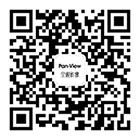
 豫公网安备 41019602002106号
豫公网安备 41019602002106号